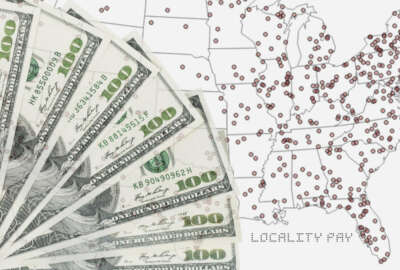After 2% federal pay raise for 2025, pay compression spreads a little further
Most civilian feds got a 2% federal pay raise for 2025, but certain senior-level feds working in some locality pay areas will see reduced pay raises.
President Joe Biden opted for a 2% average federal pay raise for civilian employees in 2025, but some employees in the higher grades and steps of the General Schedule will see an even smaller pay adjustment.
Although most federal employees will receive a pay bump somewhere around the 2% figure when they open their first paychecks of the new year, senior-level feds working in certain locality pay areas will continue to experience pay compression — a decades-old phenomenon in the federal pay system.
Pay compression worsens slightly in most years due to the annual federal pay raise and an existing pay ceiling near the top of the General Schedule. Salaries of career GS employees, according to federal statute, cannot exceed the pay for political appointees and others at level IV on the Executive Schedule.
The salaries of those senior-level feds do increase with annual federal pay raises, but the pay ceiling means they don’t reach their “full” raises. For 2025, any GS grades and steps that would be put above a $195,200 salary after the 2% federal pay raise will see their earnings compressed down to that number.
Pay compression impacts the federal workforce differently based on what locality pay area employees fall under. Typically, in areas with higher costs of living, pay compression will occur in a higher number of GS grades and steps.
Federal News Network compiled the chart below showing exactly which GS grades and steps are impacted by pay compression across locality pay areas.
(Story continues below chart)
Asterisk (*) indicates locality pay area new to pay compression for 2025. Data from Office of Personnel Management.
Now with the 2% federal pay raise for 2025, pay compression is affecting 37 of the 58 — or about 64% — of locality pay areas. By comparison, there were 25 locality pay areas in 2020 that were impacted by pay compression to some extent.
The federal pay raise brought seven new GS grades and steps up to the point of pay compression, raising the total number of impacted grades and steps from 91 in 2024 to 98 in 2025.
Two locality pay areas — Colorado Springs, Colorado, and St. Louis, Illinois — are experiencing some level of pay compression for the first time ever this year.
Pay compression has worsened over time, as most GS employees continue to receive annual pay raises, and those at the very top of the pay system continue to receive reduced pay adjustments.
Historically, pay compression has mainly impacted feds classified as GS-15, Step 10 in certain locality pay areas. But in just the past couple of years, pay compression has spread to even more grades and steps across the country.
Pay compression is the most widespread in the San Francisco Bay Area, where a total of 10 grades and steps are now impacted. It’s the only locality area where the pay ceiling is low enough for GS-14, Step 9 and 10 employees to hit it.
For 2025, GS-15, Step 3 employees in the San Francisco Bay Area are experiencing pay compression for the first time. And after the 2% raise, employees at GS-14, Step 8 in that locality pay area have a salary of $192,004, putting them less than $3,000 away from hitting the pay ceiling.
More broadly, this year, there are 10 other GS grades and steps in various locality pay areas with salaries above $194,000. That puts them just hundreds of dollars away from the $195,200 pay ceiling. The closest group to the pay ceiling is GS-15, Step 7 employees in Sacramento, California, who are now receiving a salary of $194,846 for 2025 — just $354 shy of the pay ceiling.
Not only does pay compression limit an employee’s salary in any given year, but it can also create impacts that last into retirement. The pay cap can make a difference of thousands of dollars in retirement annuities, according to a Federal News Network data analysis from 2020.
In both the fiscal 2024 and fiscal 2025 budget requests, the Biden administration hinted at plans to issue a legislative proposal to address pay compression. But in the last two years, the administration ultimately did not issue a proposal on the topic.
The Senior Executives Association — a federal employee group that’s been vocal about the issue for decades — has argued that pay compression disincentivizes federal employees from pursuing more senior positions in the government. It can also contribute to morale and satisfaction challenges in the workforce.
“While initially encouraged by the current administration’s position on addressing pay compression, progress has been lacking,” SEA President Marcus Hill said in a statement. “We look forward to engaging with leaders from the new administration and new Congress to pursue much needed modernization and change, including on the important issue of pay compression. To position the federal government to attract, recruit and retain talented executives, professionals and technical experts, policymakers must prioritize and act immediately to resolve this long-standing, continuous impediment.”
Copyright © 2025 Federal News Network. All rights reserved. This website is not intended for users located within the European Economic Area.
Drew Friedman is a workforce, pay and benefits reporter for Federal News Network.
Follow @dfriedmanWFED






